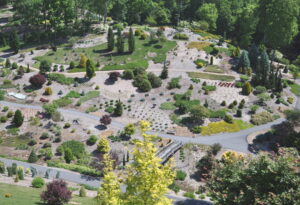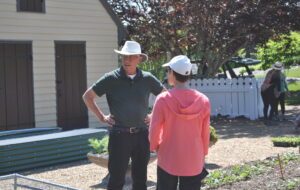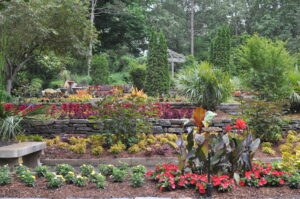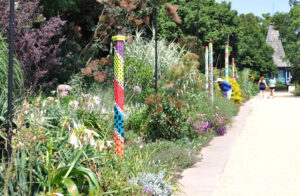A “Hobby Gone Awry”
June 20th, 2023
Dr. Ronald Stanley was a fledgling dermatologist when he and his new wife, Cheryl, built a house in 1979 on five acres in the Blue Ridge Mountains of western North Carolina.

The first view of Arborcrest Gardens from above.
At first, Stanley focused on a rather large and innovative vegetable garden that was good enough to be featured on PBS’ Victory Garden show.
Then he graduated into landscaping with trees, shrubs, conifers, and flowers while adding another 45 steeply sloping adjoining acres in 1985.
Things started to get out of control in 2009 when Stanley cut his first trail through the new land.
Fourteen years later, the Stanleys’ property has grown into a 26-acre botanical garden with two-and-a-half miles of trails. It’s planted with a staggering five million plants of 15,000 different varieties – essentially a home garden with more plants than most public gardens.
The place is called Arborcrest Gardens, and it’s open on a limited basis to the public – only on Fridays during the growing season and only by reservation.
I got to see this “High Country hidden gem” on a Lowee’s Group Tour earlier this month of North Carolina gardens.
This is a garden worth putting on your radar if you’re ever near Boone, N.C., which is a small mountain city that’s home to Appalachian State University.
What’s especially mind-blowing is that this vast creation is primarily the work of one man.
Stanley will tell you that Arborcrest is a “hobby gone awry” and that it’s what happens when a plant-obsessed gardener isn’t limited by space.
Unlike most other public gardens that started out as private estates (a la Longwood, Chanticleer, and Winterthur), this creator is still alive and still very much in the creation stage.

Arborcrest Gardens is the work of this ambitious fellow — Dr. Ronald Stanley.
Even though Stanley now has a staff of four full-time and two part-time gardeners, he’s still the one visioning the design, selecting the plants, and laying out the beds with his trusty cans of spray paint.
He spends 40 to 60 hours every week working on the gardens, all while continuing to work as a dermatologist three days a week.
He’s an ambitious fellow, if you haven’t guessed.
Stanley got the gardening bug at age six when his grandmother gave him a corner of her vegetable garden. He found it to be miraculous how little seeds could turn into big (and delicious) plants, which fueled his lifelong interest.
Stanley has been particularly influenced by the gardens at Walt Disney World, which gives you some idea of the scale and style of Arborcrest.
The first view of the gardens is one of the biggest “wow” moments you’ll see in a public garden because acres of the colorful swoops open to view all at once from above. Since the house and parking lot are above, you have no idea what’s below until you walk over to the valley’s edge.
Two-and-a-half miles of paved trails now wind through the sloped gardens – about half of it in open sunlight and half in wooded areas.

Much of Arborcrest is planted on these steep slopes.
It’s not the easiest garden to navigate because of the steepness. Parking limits the number of visitors for now, but as the gardens become more open to the public in the future, it’s likely that some sort of tram system will be needed.
If you’re a plant-lover, you’ll find swoops of cutting-edge plants of all kinds – large trees and evergreens, dwarf conifers, clusters of blooming perennials and annuals, and specimens such as the super-slow-growing, decades-old Japanese maple that’s only a foot tall.
Although the garden is seven hours southwest of Harrisburg, the growing zone is similar because Arborcrest’s elevation is nearly 3,400 feet above sea level. It’s actually a bit cooler in summer than we are, topping out in the 80s.
Most of the plants that do well there can also be grown in southcentral Pennsylvania – and then some.
If you’re interested in seeing Arborcrest first-hand, reservations and more information are available on the Gardens’ website. The website also is a treasure trove of plant information, including a list of every plant in the garden and how it’s performed.
Our North Carolina trip also took us to three public gardens run by the state’s three major universities in and around Raleigh.

Some of the colorful terraces at the Sarah P. Duke Gardens.
My favorite of the three was the Sarah P. Duke Gardens on the campus of Duke University in Durham.
These gardens span 55 acres and feature some interesting theme gardens (a white garden, a kids-geared edible garden, a Japanese woodland garden, a huge native-plant garden), plus lots of peaceful strolling paths through blooming gardens and woods.
The flagship feature is a series of terraced gardens that lead down a hillside, from an ornate gazebo at the top to a pond with a waterfall at the bottom.
Dozens of these big terraces are filled this year with hot-colored annuals – coleus, pentas, lantana, cannas, marigolds, and more. Grasses and conifers add structure to the wall-to-wall blazing color.
It’s quite a site and unlike any garden I’ve ever seen. It alone was worth the trip south. And it’s even a free garden to visit (except for paying to park).

The perennial border at the J.C. Raulston Arboretum.
My second favorite of the university gardens was the J.C. Raulston Arboretum of North Carolina State University.
This one isn’t as big as Sarah Duke Gardens, but it’s even more packed with plants. Despite the name, Raulston Arboretum is far more than a collection of trees.
For starters, it features a large section of trial plants, mostly annuals but some perennials and edibles.
It also has a football-field-length perennial border, a pair of dry-plant gardens (Xeric and Scree), a lattice-covered Japanese garden, and paths lined with labeled specimen plants from throughout the world.
Like Duke Gardens, Raulston is a free garden.

The carnivorous plant garden at the North Carolina Botanical Garden.
The third university garden we saw was the North Carolina Botanical Garden in Chapel Hill.
Distinctly different from the other two, NCBG focuses almost exclusively on native plants and is set mostly in woodlands (i.e. lots of shady natives that grow in the Southeast and beyond).
One of the most interesting areas here is the collection of carnivorous plants, such as pitcher plants, venus fly traps, and sundews. Kids are especially fascinated with the hundreds of bug-eating plants in the boggy raised beds.
NCBG, another free garden, also has a nice collection of herbs, displayed by their various uses (dye, fragrance, cooking, etc.)
After the university gardens, we toured the Juniper Level Botanical Garden south of Raleigh built by plantsman extraordinaire Tony Avent, who also founded the Plant Delights Nursery. The two places are side by side (and essentially one big whole).

Part of the huge new crevice garden at Juniper Level Botanical Garden.
Plant Delights specializes in rare and unusual plants from around the world and is as much of a trial ground and plant-conservation facility as it is a nursery.
The grounds hold what Avent says is the largest collection of cold-hardy plants in the U.S. – 28,000 different species and cultivars.
He says the nursery has grown some 85,000 different kinds of plants in its 36-year existence – killing about 60,000 of them. But that’s because Avent is a sort of sacrificial gardener, trying obscure species in assorted push-the-envelope places so we home gardeners have a better idea of what might work (or not) in the real world for us.
“We’ve killed 60,000 plants, but we’ve learned something from them all,” Avent says. “It’s more important for us to learn something than to be successful.”
The Juniper Level gardens display thousands of interesting plants that you won’t see anywhere else. Two of the most interesting gardens are the new Crevice Garden – built using recycled concrete blocks and claimed as the world’s largest crevice garden – and the series of rain gardens that test all sorts of plants in differing drainage situations.
Avent has already donated the Juniper Level land and plants to his alma mater, North Carolina State University, to ensure it continues as a public garden after he’s gone.
Our trip was topped off by a pair of private home gardens – the mountainous Boone, N.C., garden of Jay Sifford (with a gorgeous four-season planting in the entire front yard) and the acre Raleigh suburban garden of David and Christine Sabio with its 98-species Japanese maple collection and backyard woodland gardens.
See photos of each of the above North Carolina gardens
Download George’s $7.95 e-book on “50 American Public Gardens You Really Ought to See.”







